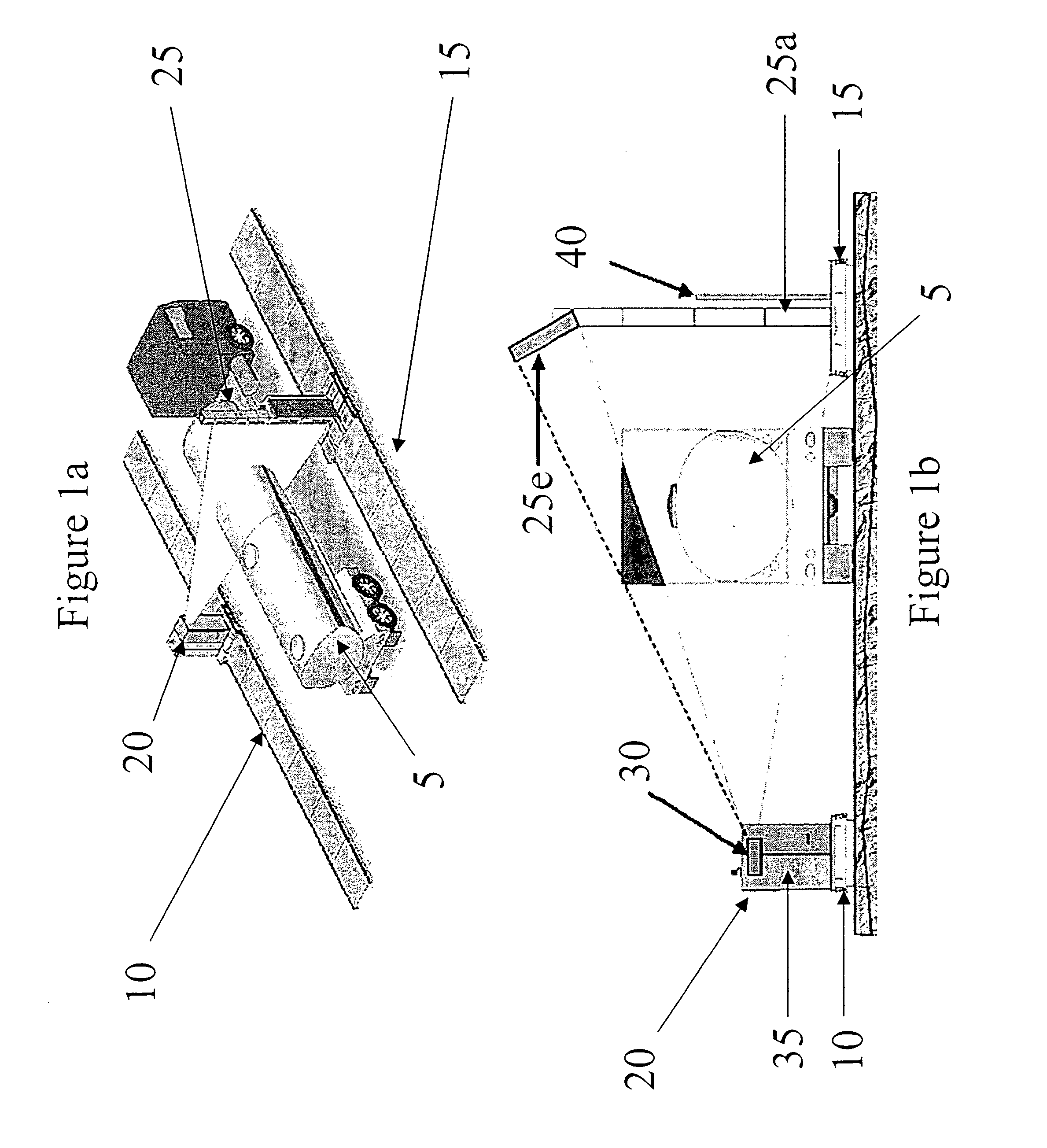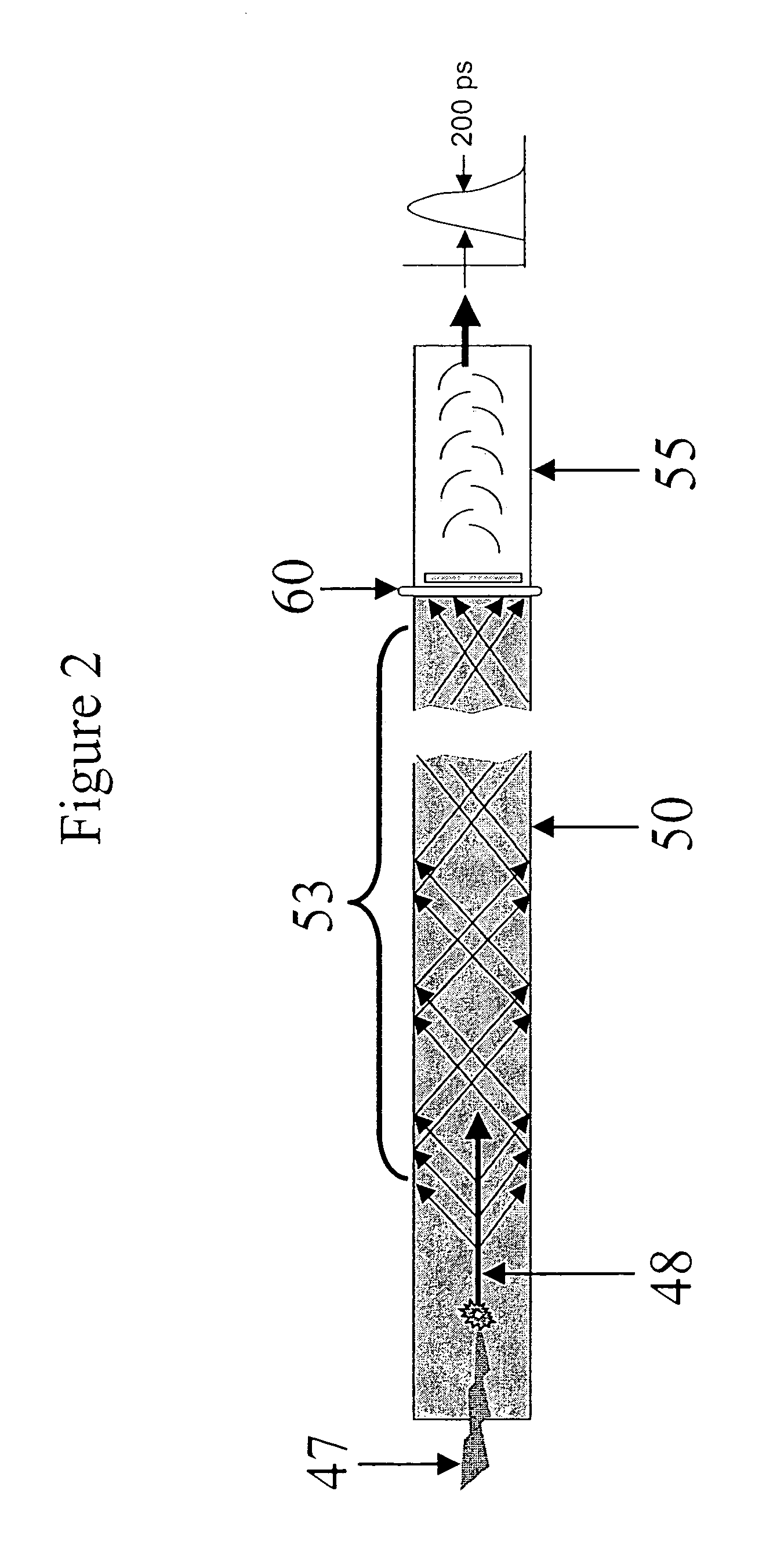Method and system for high energy, low radiation power X-ray imaging of the contents of a target
a x-ray imaging and low radiation power technology, applied in the direction of material analysis, material analysis using wave/particle radiation, instruments, etc., can solve the problems of low radiation power, low radiation power, and inability to reject off-axis radiation, so as to reduce radiation power, reduce the size and cost of the x-ray photon interaction event, and reduce the frequency of the even
- Summary
- Abstract
- Description
- Claims
- Application Information
AI Technical Summary
Benefits of technology
Problems solved by technology
Method used
Image
Examples
first embodiment
[0025]In the present invention, a relocatable dual track system is utilized as illustrated in FIGS. 1(a) and 1(b). FIG. 1(a) illustrates the basic system including a first track 10 for guiding a source 20 and a second track 15 for guiding detector component 25. The source 20 and detector component 25 are utilized in combination to image the contacts of the target 5 shown as a typical tanker truck form factor. In an alternative embodiment, the detector component 25 includes multiple detector panels 25a-X, e.g., 25a-e are shown in FIG. 1b, each of which is comprised of individual detectors, wherein detector panel 25e is angled so as to maximize detection of radiation passing through the target 5 where the target is a container cargo section as shown. With this configuration, the scan of each target is accomplished in less than 60 seconds, with throughput per hour of approximately 20-40 vehicles and scan speeds of approximately 8-12 inches per second.
[0026]Further to the first embodime...
second embodiment
[0030]In the present invention, a system and method for imaging the contents of a target includes a dual-energy, dual-imaging technique for providing data that is used to differentiate high-Z (Z stands for the average atomic number of the material by weight) materials from the low and medium Z surrounding materials. The low and medium Z materials can also be differentiated, but with less sensitivity. High-Z materials are materials with a high atomic number such as those associated with weapons of mass destruction (WMDs), e.g., material such as uranium (Z=92) and plutonium (Z=94).
[0031]Referring again to FIG. 1a, an exemplary implementation of the system includes a first track 10 for guiding a source 20 and a second track 15 for guiding detector component 25. In this second embodiment of the present invention, the source 20 is a linear accelerator (linac) operating in an interlaced mode at 5-6 MeV and 8-10 MeV end point energies. For example, linear accelerators are available from Va...
fourth embodiment
[0049]In the present invention, the target object is subjected to a follow-up inspection when a high-Z material(s) are preliminarily identified by the methods described above or by an alternative method for high-Z material identification. Once a preliminary identification of the high-Z material(s) has been made, the target object is subjected to a second scan for further analysis of the preliminarily identified material. For this second scan, the dual-energy linac described above is operated in a single mode at 9 MeV or greater. Potentially the end point energy in this scan mode could be as high as 15 MeV if this capability is built into the linac x-ray source. Neutron detectors, such as 3He pressurized detectors, bismuth germanate (BGO) scintillators, plastic scintillators, glass fiber scintillators, or any of a number of configurations using 10B, 6Li, 157Gd, B, BF3, or fission chambers can be used to detect any prompt or delayed fission neutrons resulting from the interrogation. T...
PUM
| Property | Measurement | Unit |
|---|---|---|
| time | aaaaa | aaaaa |
| beam fan angle | aaaaa | aaaaa |
| thickness | aaaaa | aaaaa |
Abstract
Description
Claims
Application Information
 Login to View More
Login to View More - R&D
- Intellectual Property
- Life Sciences
- Materials
- Tech Scout
- Unparalleled Data Quality
- Higher Quality Content
- 60% Fewer Hallucinations
Browse by: Latest US Patents, China's latest patents, Technical Efficacy Thesaurus, Application Domain, Technology Topic, Popular Technical Reports.
© 2025 PatSnap. All rights reserved.Legal|Privacy policy|Modern Slavery Act Transparency Statement|Sitemap|About US| Contact US: help@patsnap.com



